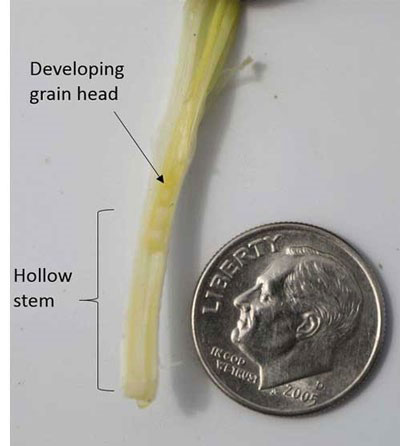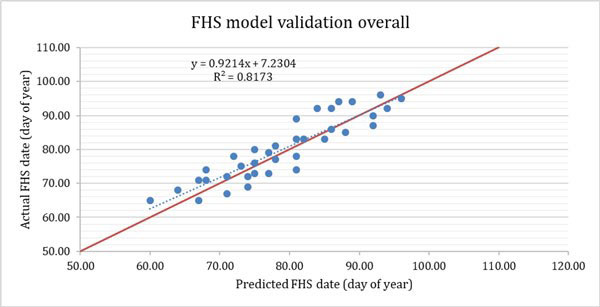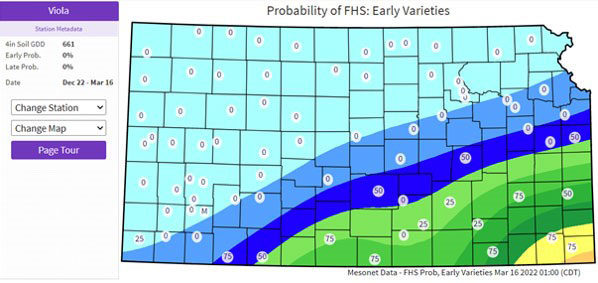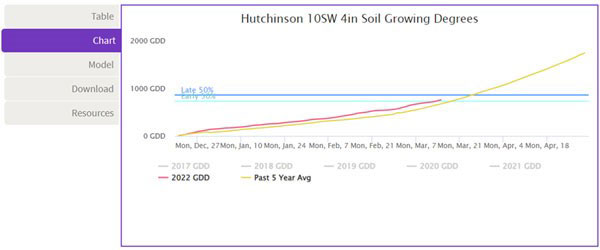Winter wheat is beginning to break dormancy, and the Kansas Mesonet has a tool to help track the crop development: Wheat First Hollow Stem (https://mesonet.k-state.edu/agriculture/wheat/hollowstem/). This page tracks soil temperature to calculate wheat growing degree days (GDD) associated with first hollow stem occurrence. This tool employs a wheat growth model developed by Oklahoma State University and the Oklahoma Mesonet, which was validated for wheat growing conditions experienced in south central Kansas during the 2016-2021 growing seasons. The output of the model provides the probability of first hollow stem occurrence (current and historical) both for early- and late-maturing wheat varieties.
Wheat First Hollow Stem
Wheat first hollow stem is the stage when there is about 1.5 cm of hollow stem growth underneath the developing wheat head (Figure 1). This is the beginning of stem elongation and, for winter wheat, it occurs in the spring after winter dormancy. This stage is important for dual-purpose wheat growers (grazing plus grain) because it is the optimal time for grazing termination to maximize forage yield while minimizing grain yield losses. The rationale is that up to this point, grazing cattle only remove foliage and consequently, yield losses due to grazing are modest. However, beyond this point, grazing can remove the developing wheat heads, increasing the potential for yield reductions due to grazing.

Figure 1. Wheat plant reaching the first hollow stem stage of growth, characterized by approximately 1.5 cm (or roughly the diameter of a dime) of hollow stem underneath the developing grain head. Photo by Romulo Lollato, K-State Research and Extension.
Calculation of Wheat GDD and Estimated Probability of First Hollow Stem
There are two different models currently in place at the Kansas Mesonet, one representing the probability of occurrence of first hollow stem for an early-maturing variety, and another for a late-maturing variety. The calculations employed in this tool are identical to those employed at the Oklahoma Mesonet, with the single difference that the model representing varieties of medium maturity in Oklahoma is used to represent varieties of late maturity in Kansas.
Both models calculate the probability of first hollow stem based on accumulated soil temperatures at the 4-inch depth, using a base temperature of 31°F and a start date of December 22 of the previous year. Soil temperature accumulation is calculated as daily soil temperature minus 31°F, and daily accumulated temperature values are summed from December 22 of the previous year until current date to estimate probability of first hollow stem. The accumulated temperatures are then contrasted with Table 1 below to determine the probability of first hollow stem at a given calendar date.
Table 1. Probability of first hollow stem for early and a late-maturing varieties based on accumulated soil temperatures at the 4-inch depth beyond 31°F. Table courtesy of Oklahoma Mesonet.
|
Probability of FHS occurrence |
Accumulated soil temperature beyond 31°F |
|
|
|
Early |
Late (note that this model is for medium varieties in Oklahoma) |
|
2.5% |
543 |
702 |
|
5.0% |
576 |
731 |
|
10.0% |
612 |
763 |
|
25.0% |
670 |
812 |
|
50.0% |
734 |
864 |
|
75.0% |
809 |
920 |
|
90.0% |
879 |
980 |
|
95.0% |
935 |
1022 |
|
97.5% |
991 |
1065 |
We acknowledge that these models were developed in Oklahoma. To ensure their accuracy in Kansas, we tested their performance against six years of first hollow stem data collected near Hutchinson, Kansas. The model performance was excellent, with r2 = 0.92 and root mean square error of 4.1 days (Figure 2).

Figure 2. Predicted versus actual first hollow stem dates (day of year) for data collected near Hutchinson, KS, during 2016-2021. For each year, model performance was compared against 25, 50, and 75% probabilities for early- and late-maturing varieties. Note that the Oklahoma model for medium-maturing varieties is used for late-varieties in Kansas.
How might you benefit from the Kansas Mesonet Wheat First Hollow Stem page?
Here are a few examples:
- See an estimated probability of FHS across the state for varieties with contrasting maturities. In “Change Map”, select either “Early probability” or “Late probability” to see the probability of first hollow stem occurrence across the entire state. The example below illustrates the statewide probability of first hollow stem for early maturing varieties across the state, with greater changes in SE KS (75% probability) and SC KS (25-75% probability depending on station) chance as compared to the rest of the state (0% probability).

- Compare previous years with a chart. Select chart tab within the wheat growth tools. By selecting specific years of interest, it is possible to compare the current year to other recent years and the 5-yr average for a given location. Current data supports comparisons between 2017-present year. The solid blue lines indicate when an early (light blue) or late (dark blue) varieties are expected to reach 50% probability of first hollow stem. The example below illustrates a comparison made for Hutchinson KS. Note how the current year (red line) is slightly earlier than the 5-yr average (yellow line).

- Statewide statistics: The table lets you quickly view and sort data from across the state. You can also download data to perform your own analysis (see the Download tab).
- Graphics and social media: Download any of the maps in .PNG format for easy sharing.
Romulo Lollato, Wheat and Forage Extension Specialist
lollato@ksu.edu
Daniel Regier, Kansas Mesonet
regierdp@ksu.edu
Christopher “Chip” Redmond, Kansas Mesonet
christopherredmond@ksu.edu
Erick DeWolf, Wheat Pathology Specialist
dewolf1@ksu.edu